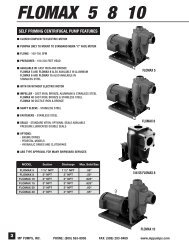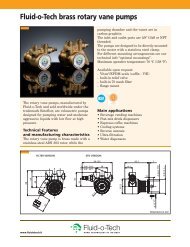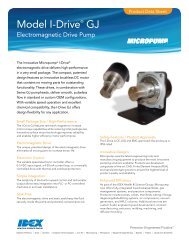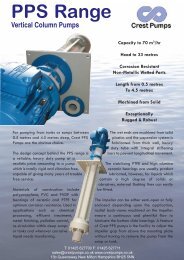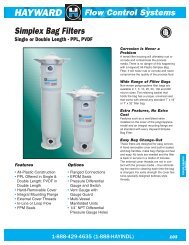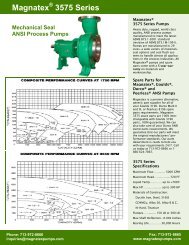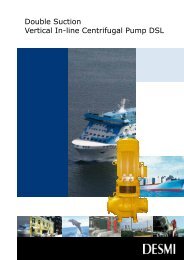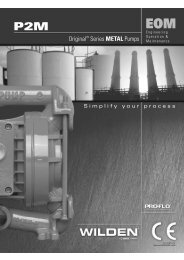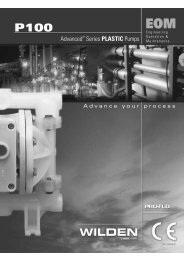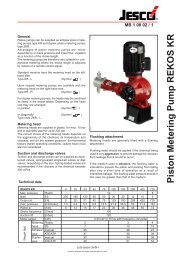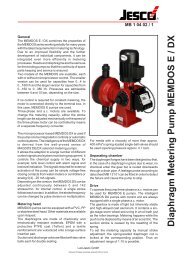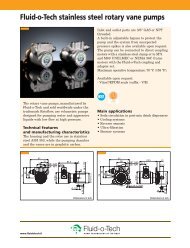P15/PV15 - Process Pumps
P15/PV15 - Process Pumps
P15/PV15 - Process Pumps
- No tags were found...
You also want an ePaper? Increase the reach of your titles
YUMPU automatically turns print PDFs into web optimized ePapers that Google loves.
Section 6SUGGESTED INSTALLATIONWilden pumps are designed to meet the performancerequirements of even the most demanding pumpingapplications. They have been designed and manufacturedto the highest standards and are available in a variety ofliquid path materials to meet your chemical resistanceneeds. Refer to the performance section of this manual foran in-depth analysis of the performance characteristics ofyour pump. Wilden offers the widest variety of elastomeroptions in the industry to satisfy temperature, chemicalcompatibility, abrasion resistance and flex concerns.The suction pipe size should be at least the equivalent orlarger than the diameter size of the suction inlet on yourWilden pump. The suction hose must be non-collapsible,reinforced type as these pumps are capable of pulling a highvacuum. Discharge piping should also be the equivalentor larger than the diameter of the pump discharge whichwill help reduce friction losses. It is critical that all fittingsand connections are airtight or a reduction or loss of pumpsuction capability will result.INSTALLATION: Months of careful planning, study,and selection efforts can result in unsatisfactory pumpperformance if installation details are left to chance.Premature failure and long term dissatisfaction can beavoided if reasonable care is exercised throughout theinstallation process.LOCATION: Noise, safety, and other logistical factors usuallydictate where equipment will be situated on the productionfloor. Multiple installations with conflicting requirementscan result in congestion of utility areas, leaving few choicesfor additional pumps.Within the framework of these and other existing conditions,every pump should be located in such a way that six keyfactors are balanced against each other to maximumadvantage.ACCESS: First of all, the location should be accessible. Ifit’s easy to reach the pump, maintenance personnel willhave an easier time carrying out routine inspections andadjustments. Should major repairs become necessary, easeof access can play a key role in speeding the repair processand reducing total downtime.AIR SUPPLY: Every pump location should have an air linelarge enough to supply the volume of air necessary toachieve the desired pumping rate. Use air pressure up toa maximum of 8.6 bar (125 psig) depending on pumpingrequirements.For best results, the pumps should use a 5μ (micron) airfilter, needle valve and regulator. The use of an air filterbefore the pump will ensure that the majority of any pipelinecontaminants will be eliminated.SOLENOID OPERATION: When operation is controlled by asolenoid valve in the air line, three-way valves should beused. This valve allows trapped air between the valve andthe pump to bleed off which improves pump performance.Pumping volume can be estimated by counting the numberof strokes per minute and then multiplying the figure by thedisplacement per stroke.MUFFLER: Sound levels are reduced below OSHAspecifications using the standard Wilden muffler. Othermufflers can be used to further reduce sound levels, butthey usually reduce pump performance.ELEVATION: Selecting a site that is well within the pump’sdynamic lift capability will assure that loss-of-prime issues willbe eliminated. In addition, pump efficiency can be adverselyaffected if proper attention is not given to site location.PIPING: Final determination of the pump site should not bemade until the piping challenges of each possible locationhave been evaluated. The impact of current and futureinstallations should be considered ahead of time to makesure that inadvertent restrictions are not created for anyremaining sites.The best choice possible will be a site involving the shortestand straightest hook-up of suction and discharge piping.Unnecessary elbows, bends, and fittings should be avoided.Pipe sizes should be selected to keep friction losses withinpractical limits. All piping should be supported independentlyof the pump. In addition, the piping should be aligned toavoid placing stress on the pump fittings.Flexible hose can be installed to aid in absorbing the forcescreated by the natural reciprocating action of the pump. If thepump is to be bolted down to a solid location, a mountingpad placed between the pump and the foundation will assistin minimizing pump vibration. Flexible connections betweenthe pump and rigid piping will also assist in minimizingpump vibration. If quick-closing valves are installed at anypoint in the discharge system, or if pulsation within a systembecomes a problem, a surge suppressor (SD Equalizer ® )should be installed to protect the pump, piping and gaugesfrom surges and water hammer.If the pump is to be used in a self-priming application, makesure that all connections are airtight and that the suction lift iswithin the model’s ability. Note: Materials of construction andelastomer material have an effect on suction lift parameters.Please refer to the performance section for specifics.When pumps are installed in applications involving floodedsuction or suction head pressures, a gate valve should beinstalled in the suction line to permit closing of the line forpump service.<strong>Pumps</strong> in service with a positive suction head are most efficientwhen inlet pressure is limited to 0.5–0.7 bar (7–10 psig).Premature diaphragm failure may occur if positive suctionis 0.7 bar (10 psig) and higher.SUBMERSIBLE APPLICATIONS: Pro-Flo V pumps can beused for submersible applications, when using the Pro-FloV submersible option. Turbo-Flo pumps can also beused for submersible applications.NOTE: Pro-Flo ® and Accu-Flo pumps are not submersible.ALL WILDEN PUMPS ARE CAPABLE OF PASSING SOLIDS.A STRAINER SHOULD BE USED ON THE PUMP INTAKE TOENSURE THAT THE PUMP'S RATED SOLIDS CAPACITY ISNOT EXCEEDED.CAUTION: DO NOT EXCEED 8.6 BAR (125 PSIG) AIRSUPPLY PRESSURE.WIL-10110-E-02 8/06 11 WILDEN PUMP & ENGINEERING, LLC



